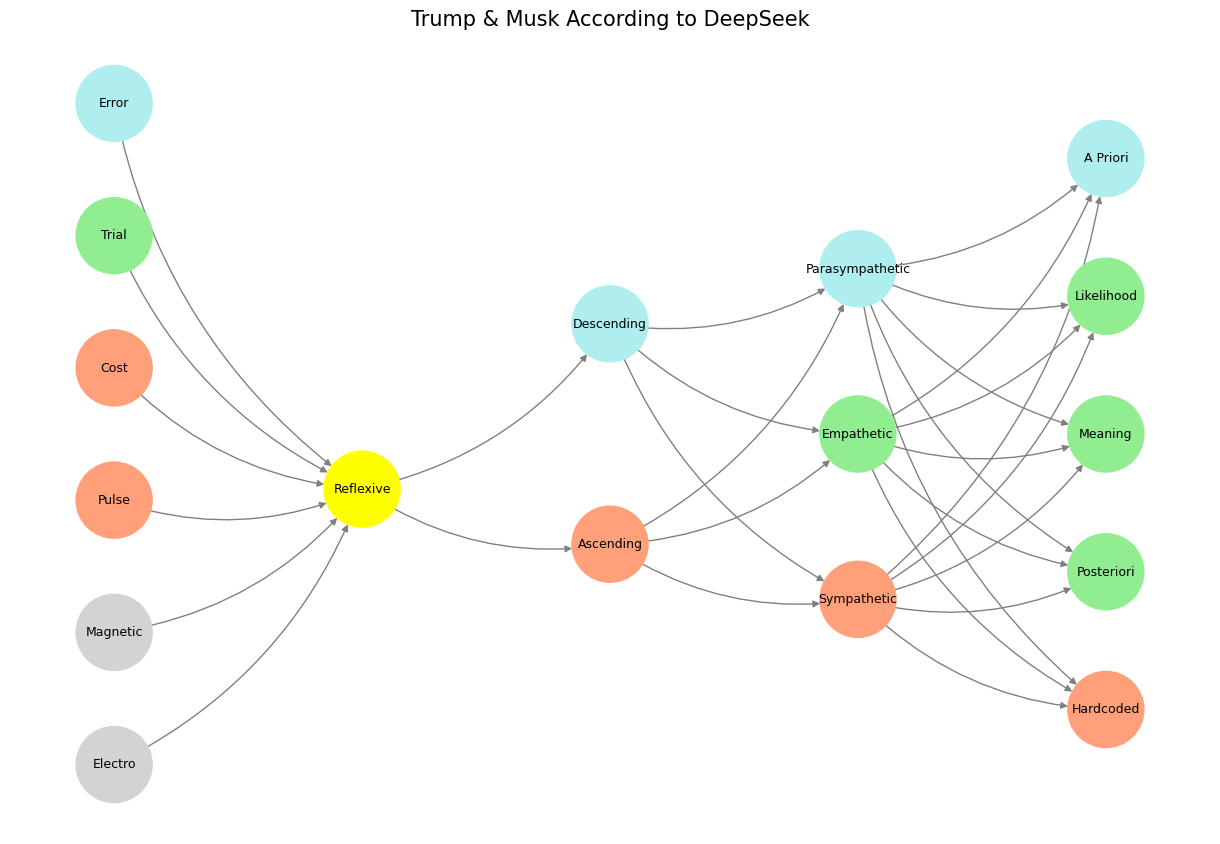Duality#
The provided code appears to be a creative and abstract representation of a neural network, blending elements of artificial intelligence, philosophy, and metaphorical storytelling. At its core, the code defines a multi-layered graph structure using the NetworkX library, where each layer represents a conceptual category, such as “World,” “Mode,” “Agent,” “Space,” and “Time.” These layers are populated with nodes that symbolize abstract ideas or processes, such as “Electro,” “Magnetic,” “Reflexive,” “Ascending,” “Sympathetic,” and “A Priori.” The connections between these nodes suggest a flow of information or influence, mimicking the structure of a neural network but applied to a more philosophical or metaphorical framework.
The layers and their corresponding nodes seem to explore themes of existence, cognition, and decision-making. For instance, the “World” layer includes terms like “Electro,” “Magnetic,” and “Pulse,” which could symbolize fundamental forces or principles governing reality. The “Mode” layer contains “Reflexive,” hinting at automatic or instinctive responses. The “Agent” layer introduces duality with “Ascending” and “Descending,” possibly representing opposing forces or directions in thought or action. The “Space” and “Time” layers delve into more abstract concepts, such as “Sympathetic,” “Empathetic,” “Hardcoded,” and “Likelihood,” which could reflect the interplay between emotional, logical, and temporal dimensions of existence.

Fig. 12 Games People Play. The five realms in which the games exist are resource (inherited, orphan), need (transform, stagnate, squander), cost (brand, oblivion), means (weaponize, tokenize, monopolize – in a word, personalize target), ends (cadence). See also Posteriori, γ 😃 ⭕️. Most neural network models are designed to minimize the ecological cost function, which is synonymous with maximizing the efficiency and means by which our agent-protagonist navigates the labyrinth of life – none of the madness of Odysseus. From this perspective, the cadence is merely a final leap along an efficiency frontier. Morality, represented by the Plagal – or even Authentic – cadence operates on similar terms. Demands a narrative rather than unbounded exploration of the massive combinatorial space of life. In Milos’s Amadeus, the film follows a very specific tragectory, capturing the evolution and context of Mozart’s work. And its cadence is Mozart’s death, whose cadence is Lacrimosa, which has a Plagal cadence … Ecosystem-Integration: 1. Delete 60% 2. Simulate 10% of it 3. Optimize the new thing. Please don’t optimize a thing that shouldn’t exist. Ditto, iterate, faster, automating …#
The color mapping adds another layer of meaning, assigning specific hues to nodes based on their conceptual roles. For example, “Reflexive” is colored yellow, perhaps indicating alertness or caution, while nodes like “Error” and “A Priori” are given a pale turquoise, possibly symbolizing clarity or detachment. The use of light green for “Trial,” “Empathetic,” and “Likelihood” might suggest growth, harmony, or probability, while light salmon for “Pulse,” “Cost,” and “Hardcoded” could imply urgency, sacrifice, or rigidity. These color choices enhance the visual representation and reinforce the thematic connections between the nodes.
The title of the visualization, “Trump & Musk According to GPT,” introduces an intriguing layer of interpretation. It suggests that the graph might be a metaphorical commentary on the ideologies, behaviors, or influences of two prominent figures: Donald Trump and Elon Musk. The layers and nodes could represent different aspects of their personalities, decision-making processes, or impacts on society. For example, “Electro” and “Magnetic” might symbolize their ability to attract attention or polarize opinions, while “Reflexive” could reflect their instinctive or impulsive tendencies. The duality of “Ascending” and “Descending” might represent their contrasting approaches to leadership or innovation.
Overall, the code seems to be an artistic exploration of complex ideas, using the structure of a neural network as a metaphor for interconnected systems of thought, behavior, and influence. It invites viewers to interpret the relationships between the nodes and layers, drawing connections between abstract concepts and real-world phenomena. The inclusion of Trump and Musk in the title adds a contemporary and provocative dimension, suggesting that the graph might be a commentary on their roles in shaping modern society. Whether intended as a philosophical exercise, a piece of digital art, or a satirical take on AI and human behavior, the code serves as a thought-provoking blend of technology and metaphor.
Show code cell source
import numpy as np
import matplotlib.pyplot as plt
import networkx as nx
# Define the neural network fractal
def define_layers():
return {
'World': ['Electro', 'Magnetic', 'Pulse', 'Cost', 'Trial', 'Error', ], # Veni; 95/5
'Mode': ['Reflexive'], # Vidi; 80/20
'Agent': ['Ascending', 'Descending'], # Vici; Veni; 51/49
'Space': ['Sympathetic', 'Empathetic', 'Parasympathetic'], # Vidi; 20/80
'Time': ['Hardcoded', 'Posteriori', 'Meaning', 'Likelihood', 'A Priori'] # Vici; 5/95
}
# Assign colors to nodes
def assign_colors():
color_map = {
'yellow': ['Reflexive'],
'paleturquoise': ['Error', 'Descending', 'Parasympathetic', 'A Priori'],
'lightgreen': ['Trial', 'Empathetic', 'Likelihood', 'Meaning', 'Posteriori'],
'lightsalmon': [
'Pulse', 'Cost', 'Ascending',
'Sympathetic', 'Hardcoded'
],
}
return {node: color for color, nodes in color_map.items() for node in nodes}
# Calculate positions for nodes
def calculate_positions(layer, x_offset):
y_positions = np.linspace(-len(layer) / 2, len(layer) / 2, len(layer))
return [(x_offset, y) for y in y_positions]
# Create and visualize the neural network graph
def visualize_nn():
layers = define_layers()
colors = assign_colors()
G = nx.DiGraph()
pos = {}
node_colors = []
# Add nodes and assign positions
for i, (layer_name, nodes) in enumerate(layers.items()):
positions = calculate_positions(nodes, x_offset=i * 2)
for node, position in zip(nodes, positions):
G.add_node(node, layer=layer_name)
pos[node] = position
node_colors.append(colors.get(node, 'lightgray'))
# Add edges (automated for consecutive layers)
layer_names = list(layers.keys())
for i in range(len(layer_names) - 1):
source_layer, target_layer = layer_names[i], layer_names[i + 1]
for source in layers[source_layer]:
for target in layers[target_layer]:
G.add_edge(source, target)
# Draw the graph
plt.figure(figsize=(12, 8))
nx.draw(
G, pos, with_labels=True, node_color=node_colors, edge_color='gray',
node_size=3000, font_size=9, connectionstyle="arc3,rad=0.2"
)
plt.title("Trump & Musk According to DeepSeek", fontsize=15)
plt.show()
# Run the visualization
visualize_nn()


Fig. 13 Tryptophan, Tryptamine, and Y’all Who Be Trippin’. Information in nature is encoded in gravity and photons and zapped from the cosmos, to earth, to life, to silicon. As for the point of view, thats open for discourse. Source: Lorenzo Expeditions. And if we invert all the aforementioned, then we might say something like: The code provides a unique blend of art and science, creating a visual narrative that might engage viewers in thinking about the structure of thought, decision-making, or the whimsical nature of reality as depicted in “Alice’s Adventures in Wonderland” - Grok-2.#

